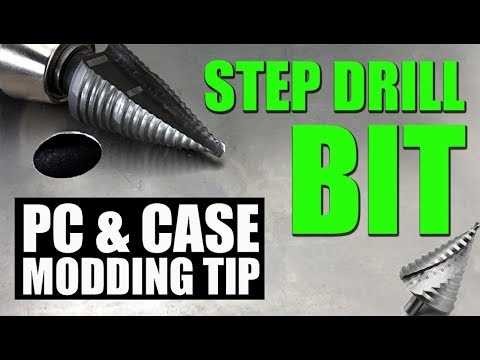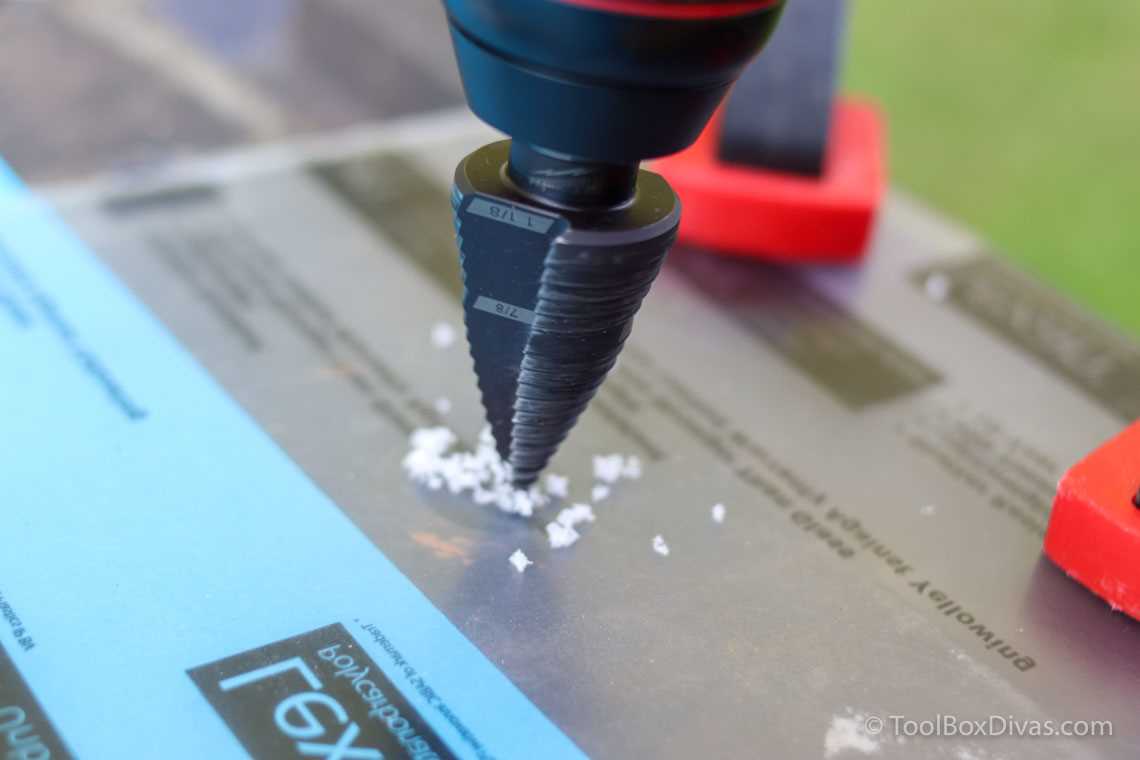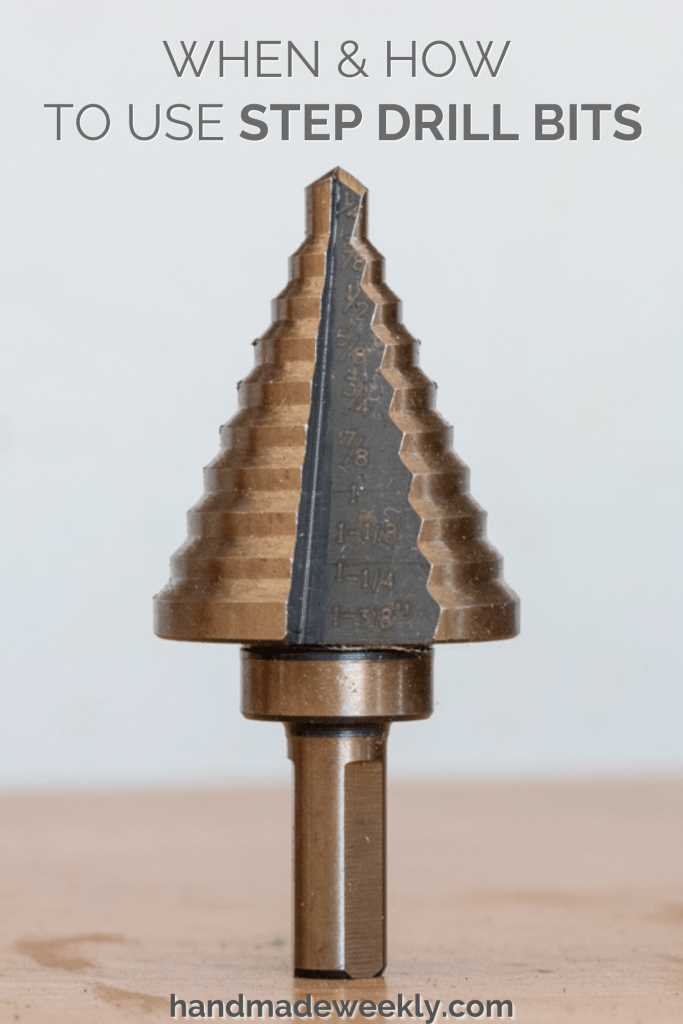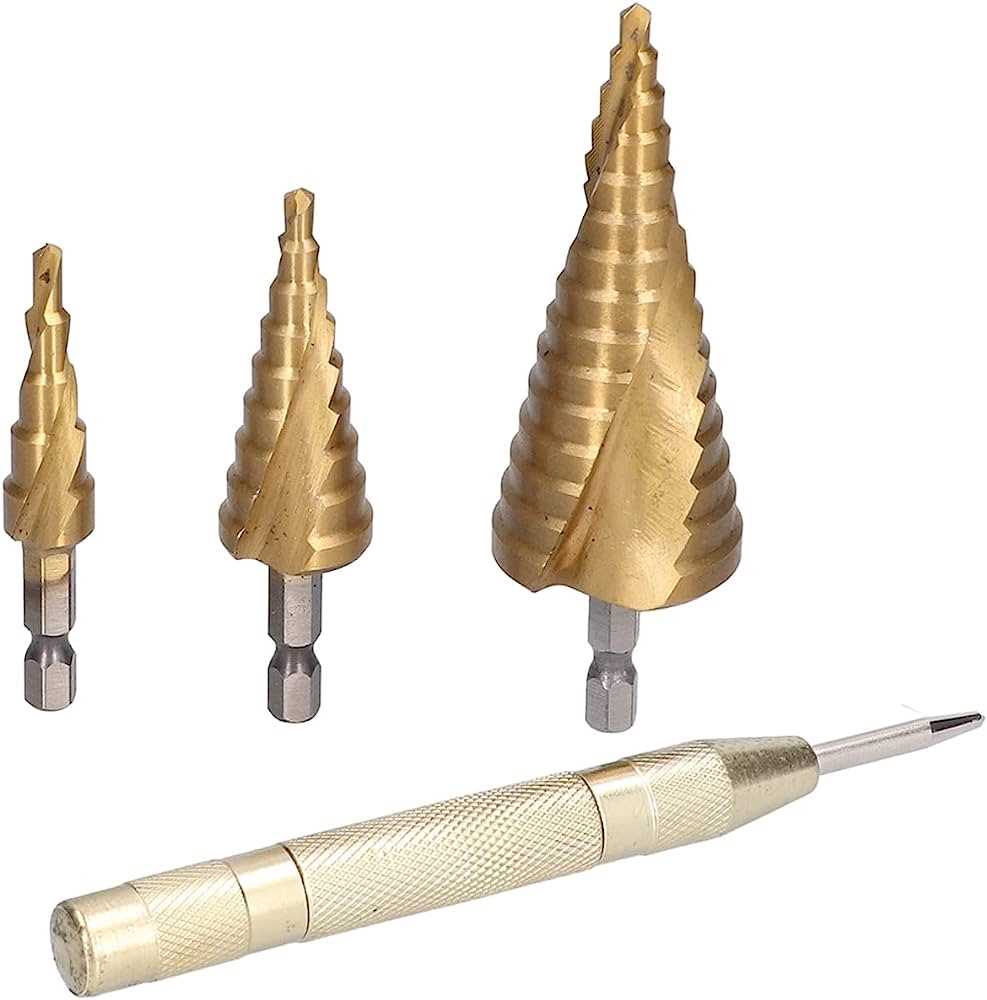What is a step drill bit used for

A step drill bit is a versatile tool that is used for drilling holes of different sizes in various materials. It is designed to enlarge existing holes or create new ones with a smooth finish, without the need for multiple drill bits.
Step drill bits are commonly used in metalworking, woodworking, and plumbing applications. They are particularly useful in situations where a range of hole sizes is needed, such as when installing electrical conduits or plumbing pipes.
The unique design of a step drill bit allows it to create multiple hole sizes by gradually widening the hole with each step. This eliminates the need for switching between different drill bits and reduces the time and effort required for drilling.
For example, a step drill bit can start with a small pilot hole and then gradually enlarge it to a larger diameter, creating a perfectly sized hole for a screw or a bolt.
The stepped design of the bit also helps prevent the material from chipping or cracking, resulting in cleaner and more precise holes. Additionally, step drill bits often have a self-starting tip that eliminates the need for center punching or drilling pilot holes, making them convenient and efficient to use.
Overall, the versatility, convenience, and precision of step drill bits make them an essential tool for various industries and applications.
What is a Step Drill Bit Used for?
A step drill bit is a special type of drill bit that is designed to create holes of different diameters in a variety of materials. It is commonly used in metalworking applications, but can also be used on other types of materials such as plastic or wood.
Benefits of Using a Step Drill Bit
- Versatility: A step drill bit provides the ability to create multiple hole sizes with just one tool. This can be especially useful when working with materials that require different hole sizes for different components.
- Smooth and Clean Holes: Step drill bits are designed to create smooth and clean holes without the need for additional deburring or reaming. This can save time and effort when drilling multiple holes.
- Reduced Chance of Drill Bit Slippage: The stepped design of a step drill bit reduces the chance of the drill bit slipping or wandering during the drilling process. This can help to ensure accurate and precise hole placement.
- Suitable for Thin Materials: Step drill bits are ideal for drilling holes in thin materials that may be prone to cracking or splintering. The stepped design of the bit helps to prevent excessive material removal and minimizes the risk of damage.
Applications of Step Drill Bits
Step drill bits have a wide range of applications in various industries and tasks. Some common uses include:
- Sheet Metal Fabrication: Step drill bits are frequently used in sheet metal fabrication for creating holes of different sizes in thin metal sheets or panels.
- Automotive Repair and Maintenance: Step drill bits can be used in automotive repair and maintenance tasks, such as drilling holes for installing accessories or modifying body panels.
- Electrical Installations: Step drill bits are often used by electricians for drilling holes in electrical enclosures or panels to accommodate wires, conduit, or other electrical components.
- Plumbing: Step drill bits can be used in plumbing applications for drilling holes in pipes or fixtures for installation or repairs.
- DIY Projects: Step drill bits are a useful tool for DIY enthusiasts and hobbyists who often work with different materials and need to create holes of various sizes.
Overall, a step drill bit is a versatile tool that provides the convenience of multiple hole sizes in one tool. Whether you are a professional in the metalworking industry or a DIY enthusiast, a step drill bit can be a valuable addition to your toolbox.
Drilling Multiple Hole Sizes
A step drill bit is a versatile tool that can be used to drill multiple hole sizes in a variety of materials. It is designed with a gradual increase in diameter, allowing it to create holes of different sizes without the need for multiple bits.
Benefits of Using a Step Drill Bit
Using a step drill bit offers several advantages over traditional drill bits:
- Efficiency: Step drill bits can quickly and easily create multiple hole sizes in one operation, saving time and effort.
- Versatility: These bits can be used on various materials such as metal, wood, plastic, and more, making them suitable for a wide range of projects.
- Clean and Accurate Holes: Step drill bits produce precise holes with smooth edges, reducing the need for additional finishing work.
- Space-saving: With a single step drill bit, you can achieve the same results as multiple traditional drill bits, saving space in your toolbox.
How to Use a Step Drill Bit
Using a step drill bit is relatively simple:
- Secure the material you want to drill into, ensuring it is stable and won’t move during the drilling process.
- Mark the desired locations for the holes with a pencil or marker.
- Place the tip of the step drill bit on the marked spot and apply gentle pressure to start drilling.
- As you drill, the step drill bit will gradually increase in diameter, creating the desired hole size.
- Continue drilling until you have reached the desired depth or have achieved the necessary hole size.
- Remove the step drill bit from the material and repeat the process for any additional holes.
Applications of Step Drill Bits
Step drill bits are commonly used in various applications:
- Metalworking: Step drill bits are often used in metal fabrication, allowing precise drilling for screws, rivets, or other fasteners.
- Woodworking: These bits are suitable for woodworking projects that require different hole sizes, such as installing hardware or creating dowel joints.
- Plumbing: Step drill bits can be used to create holes for pipes and plumbing fixtures, ensuring a precise fit and proper installation.
- Electronics: In electronics assembly and repair, step drill bits can be used to create holes for mounting components or running wires.
Whether you are a professional tradesperson or a DIY enthusiast, a step drill bit is a valuable tool to have in your arsenal. With its ability to drill multiple hole sizes, it offers convenience, efficiency, and versatility for a range of projects.
Creating Cleaner, More Accurate Holes
Step drill bits are a versatile tool designed to create cleaner and more accurate holes in various materials. Whether you are working with metal, wood, plastic, or other materials, a step drill bit can provide you with precise and efficient results.
1. Multiple Hole Sizes

One of the key advantages of using a step drill bit is its ability to create multiple hole sizes with just one tool. These bits have a unique design featuring multiple steps or tiers, with each tier having a different diameter. As you drill, the bit gradually increases in size, allowing you to create holes of different sizes without changing the bit.
2. Smooth Hole Edges
Step drill bits are known for their clean-cutting action, which results in smoother hole edges. The stepped design helps to prevent tearing or splintering of the material, ensuring a neater and more professional finish. This is particularly important when working with delicate materials like wood or laminates.
3. Reduced Chatter and Walking
Chatter and walking are common issues when drilling holes, especially in metal or other hard materials. Step drill bits have a self-centering point that reduces the likelihood of the bit wandering or slipping, resulting in more accurate hole placement and reduced chatter. This self-centering feature eliminates the need for center punching or pilot holes in most cases, saving time and effort.
4. Increased Speed and Efficiency
Step drill bits are designed for fast and efficient drilling. The stepped design allows for faster chip clearance, reducing the likelihood of clogging and overheating. This makes them ideal for repetitive drilling tasks or when working on production lines where speed and efficiency are essential.
5. Wide Range of Applications
Step drill bits are extremely versatile and can be used in a wide range of applications. They are commonly used in electrical work, plumbing, automotive repair, and DIY projects. Whether you need to drill holes for cable glands, create holes for installing faucets or sinks, or enlarge existing holes, a step drill bit can handle the task with ease.
| Advantages | Description |
|---|---|
| Multiple Hole Sizes | Step drill bits can create multiple hole sizes without changing the bit. |
| Smooth Hole Edges | Step drill bits provide clean-cutting action for smoother hole edges. |
| Reduced Chatter and Walking | Step drill bits have a self-centering point that reduces chatter and wandering. |
| Increased Speed and Efficiency | Step drill bits are designed for fast and efficient drilling. |
| Wide Range of Applications | Step drill bits can be used in various industries and DIY projects. |
Reducing the Need for Multiple Drill Bits
A step drill bit is a versatile tool that can greatly reduce the need for multiple drill bits in various drilling applications. It is designed to progressively enlarge a hole in a material, and it is commonly used in metalworking and woodworking projects.
Advantages of Using a Step Drill Bit
Using a step drill bit offers several advantages compared to using traditional drill bits:
- Multiple Hole Sizes: Step drill bits have multiple cutting edges with different diameters, allowing them to create multiple hole sizes without changing the bit.
- Smooth Hole Finishes: The step design of the bit helps to create smooth, clean holes with minimal burrs or rough edges.
- Reduced Chip Buildup: Step drill bits have special flute designs that facilitate the easy removal of chips, reducing the chances of clogging or overheating.
- Time and Cost Efficiency: By eliminating the need for multiple drill bits, a step drill bit can save time and money on tool purchases.
Common Applications

Step drill bits are commonly used in a variety of applications, such as:
- Sheet metal fabrication
- Electrical installations
- Plumbing projects
- Automotive repairs
- Woodworking
Thanks to their versatility and efficiency, step drill bits have become a popular choice for both professional craftsmen and DIY enthusiasts.
Choosing the Right Step Drill Bit
When choosing a step drill bit, it is important to consider the desired hole sizes and the material you will be drilling. Different step drill bits are designed for different applications, so selecting the right one will ensure the best results.
| Step Drill Bit Range | Material Compatibility |
|---|---|
| 1/8″ – 1/2″ | Metal, plastic, wood |
| 3/16″ – 1-3/8″ | Thin steel, aluminum, copper, brass |
| 1/4″ – 1-3/8″ | Thicker steel, stainless steel |
By considering the material and the desired hole size range, you can choose the right step drill bit to achieve precise and efficient drilling.
Working with Different Materials
Step drill bits can be used to work with a variety of different materials. Here are some common materials that can be drilled using a step drill bit:
- Metal: Step drill bits are commonly used for drilling holes in metal surfaces. The gradual step design allows for a smooth and precise drilling process, preventing the material from cracking or splitting.
- Wood: Step drill bits can also be used for drilling holes in wood. They are particularly useful for creating holes of different sizes without the need for switching between different drill bits.
- Plastic: Step drill bits are effective tools for drilling holes in plastic materials. The step design helps to prevent the plastic from melting or chipping during the drilling process.
- Fiberglass: When working with fiberglass, step drill bits are ideal due to their ability to create clean and precise holes without causing any damage to the material.
- Composite Materials: Step drill bits can also be used for drilling holes in composite materials, such as carbon fiber or laminates. The sharp and smooth cutting edges of the step drill bit allow for precise drilling without fraying or splintering the material.
It’s important to note that when working with different materials, it’s essential to use the appropriate cutting speed and apply the right amount of pressure to avoid damaging the material or the drill bit. Always follow the manufacturer’s recommendations and guidelines for the specific material being drilled.
Ideal for Plumbing and Electrical Work

Step drill bits are commonly used in plumbing and electrical work due to their versatility and ability to create different-sized holes easily. These bits are designed to efficiently drill holes in materials such as metal, plastic, wood, and even glass. Their unique stepped design allows them to gradually enlarge the hole size with each step, giving users the flexibility to achieve precise hole diameters.
Benefits of Step Drill Bits for Plumbing and Electrical Work

- Efficiency: Step drill bits make the drilling process faster and more efficient. With one bit, users can create multiple hole sizes, eliminating the need for multiple drill bits and reducing the time spent on bit changes.
- Accuracy: The stepped design of these bits ensures precise hole diameters. This is especially important in plumbing and electrical work, where accurate measurements are crucial for fitting pipes, wires, and other components.
- Versatility: Step drill bits can be used on various materials commonly encountered in plumbing and electrical work. Whether drilling through metal pipes, plastic junction boxes, or wooden surfaces, these bits can provide clean and accurate holes without causing damage to the surrounding material.
- Convenience: The step design of these bits eliminates the need to carry multiple drill bits of different sizes. This saves space in toolboxes and makes it easier for plumbers and electricians to handle their work efficiently.
Applications in Plumbing and Electrical Work
Step drill bits find a wide range of applications in plumbing and electrical work. Some common uses include:
- Creating holes for plumbing pipes and fittings.
- Drilling holes for electrical outlets and switches.
- Enlarging holes in junction boxes for cable entry.
- Installing conduit fittings.
- Creating holes for cable management systems.
With their efficiency, accuracy, versatility, and convenience, step drill bits have become an essential tool for plumbers and electricians, enabling them to complete their work more efficiently and accurately.
Increasing Efficiency and Speed
Benefits of Using a Step Drill Bit
- Reduced drilling time: Step drill bits are designed to provide fast, efficient drilling. With their unique stepped design, these bits can quickly remove material and create holes of different sizes without the need for multiple drill bits.
- Increased accuracy: The gradual steps found on the bit’s fluted surface allow for precise drilling. This helps to prevent the bit from wandering and ensures that the hole is drilled in the exact desired location.
- Versatility: Step drill bits can be used on a variety of materials, including metal, wood, plastic, and more. This makes them a versatile tool to have in your toolbox, as they can be used for many different projects.
Tips for Increasing Efficiency and Speed
While step drill bits already offer increased efficiency and speed compared to traditional drill bits, there are a few tips you can follow to further improve your drilling process:
- Use a drill press: When drilling larger holes or working with harder materials, using a drill press can provide more stability and control. This can help you drill faster and more accurately.
- Apply cutting fluid: For metal drilling, applying a cutting fluid can help lubricate the bit and reduce heat. This can prolong the life of the bit and make the drilling process smoother.
- Work at the right speed: Different materials may require different drilling speeds. Consult the manufacturer’s guidelines or do some research to determine the best speed for the specific material you are drilling. This can help prevent overheating and ensure accurate drilling.
- Secure your workpiece: Make sure your workpiece is securely clamped or held in place before drilling. This will prevent it from moving or vibrating during the drilling process, allowing for more accurate and efficient drilling.
Conclusion
Using a step drill bit can greatly increase efficiency and speed in your drilling projects. With their ability to quickly remove material and create holes of different sizes, these bits are a versatile tool to have in your toolbox. By following some additional tips, such as using a drill press and applying cutting fluid, you can further enhance the efficiency and speed of your drilling process.
Compatibility with Power Drills
A step drill bit is designed to be used with power drills, which provide the necessary speed and force required for efficient drilling. These bits are compatible with both corded and cordless power drills, allowing for versatility in use.
When using a step drill bit with a power drill, it is important to ensure that the bit is securely fastened in the drill chuck. This will prevent the bit from slipping or coming loose during operation, which can be both dangerous and detrimental to the drilling process.
Step drill bits are often equipped with a hex shank, which allows for easy insertion and removal from the drill chuck. This feature ensures compatibility with a wide range of power drills, as most drills are designed to accommodate hex shank bits.
It is worth noting that the compatibility of a step drill bit with a power drill also depends on the size and power of the drill. Some smaller or less powerful drills may not be suitable for use with larger or more heavy-duty step drill bits. It is important to consult the drill manufacturer’s guidelines and specifications to ensure compatibility.
Overall, step drill bits offer compatibility with a variety of power drills, making them a versatile tool for various drilling applications.
Versatility and Convenience
The step drill bit is a versatile tool that offers convenience in a variety of drilling applications. Its unique design allows it to perform multiple functions, making it a handy tool to have in any toolbox.
Multiple Hole Sizes
One of the main advantages of a step drill bit is its ability to create multiple hole sizes with a single tool. The stepped design features different-sized cutting edges, allowing you to drill holes of various diameters. This eliminates the need for multiple drill bits or constantly changing bits throughout a drilling project.
Smooth and Accurate Drilling
Step drill bits are known for their ability to provide smooth and accurate drilling. The stepped design gradually enlarges the hole, preventing the bit from grabbing or snagging on the material being drilled. This ensures clean and precise holes without any chipping or splintering.
Wide Range of Materials
Step drill bits can be used on a wide range of materials, including metal, wood, plastic, and more. This versatility makes them suitable for various applications, from drilling holes in sheet metal to creating holes for wiring installations.
Convenient and Time-Saving
The convenience of a step drill bit lies in its ability to perform multiple functions without the need for additional tools. With a step drill bit, you can drill, deburr, and enlarge holes all in one tool. This saves time and eliminates the hassle of constantly switching between different tools during a project.
Compact and Portable
Step drill bits are generally compact in size, making them easy to carry and store. Their small form factor also allows them to fit in tight spaces where larger drill bits may not be able to reach. This makes them ideal for tasks that require drilling in confined areas.
Overall, the versatility and convenience of a step drill bit make it a valuable tool for any DIY enthusiast or professional tradesperson. Its ability to perform multiple functions and work on various materials makes it a go-to tool for a wide range of drilling applications.
FAQ:
What is a step drill bit used for?
A step drill bit is a specialized drill bit that is used for making holes with multiple diameters in various materials such as metal, plastic, and wood. It is specifically designed to create perfectly round and smooth holes without the need for switching between different drill bits.
How does a step drill bit work?
A step drill bit has multiple steps or levels of different diameters. Each step acts as a separate cutting edge. When the drill bit rotates, each step gradually enlarges the hole. The steps are designed in a way that removes the material in a controlled manner, resulting in clean and precise holes.
What are the advantages of using a step drill bit?
Using a step drill bit offers several advantages. Firstly, it eliminates the need for multiple drill bits, as one step drill bit can create holes of various diameters. This saves time and effort. Additionally, step drill bits produce clean and accurate holes without burrs or rough edges. They are also suitable for thinner materials that may get damaged with traditional drill bits.
What are some common applications of step drill bits?
Step drill bits are commonly used in HVAC (Heating, Ventilation, and Air Conditioning) installations for drilling holes in metal ducts, pipes, and electrical boxes. They are also used in automotive repairs, electrical work, woodworking, and various DIY projects. Step drill bits are versatile and can be used on materials such as sheet metal, plastic, acrylic, and wood.
Are step drill bits suitable for drilling through thick materials?
Step drill bits are generally better suited for drilling through thinner materials. While they can drill through thicker materials such as metal sheets, their maximum drilling depth is limited. For drilling thicker materials, it is recommended to use a twist drill bit or a hole saw.
Video:











